ISDB-T
-Digital Terrestrial Television/Sound/Data Broadcasting in Japan-
|
| (Courtesy Asia-Pacific Broadcasting Union.) |
Kenichi Tsuchida, Naohiko Iai, Masayuki Takada, Syunji Nakahara, Shigeki
Moriyama and Makoto Sasaki
(Digital Broadcasting Networks)
Integrated Services Digital Broadcasting (ISDB) is an emerging
digital broadcasting concept. With ISDB, everything is handled digitally.
The three kinds of systems, ISDB-S (Satellite), ISDB-T (Terrestrial)
and ISDB-C (Cable) were developed in Japan to provide flexibility,
expandability and commonality for the multimedia broadcasting services
using each network.
Since digital satellite broadcasting began service using ISDB-S
in December of last year in Japan, we would like to introduce the
three ISDB systems mentioned above. The ISDB-T system is explained
in this article, the second in a series of three. This article is
a reprint from ABU Technical Review No. 189. |
The Integrated Services Digital Broadcasting - Terrestrial (ISDB-T)
system was developed to provide flexibility, expandability, and commonality
for multimedia broadcasting services using terrestrial networks. ISDB-T
system adopted the Band Segmented Transmission - Orthogonal Frequency
Division Multiplexing (BST-OFDM), which consists of a set of frequency
blocks called OFDM segments. ISDB-T can provide services for both stationary
and mobile receivers simultaneously, because BST-OFDM uses a set of OFDM
segments with different transmission parameters to allow hierarchical
transmission. To confirm the feasibility in real broadcast environments,
pilot broadcast stations have been set up in 11 major areas of Japan.
The results of the field trials showed the feasibility of ISDB-T system
for digital terrestrial television/sound/data broadcasting services.
The digital terrestrial broadcasting system has been discussed in Japan
by the Telecommunications Technology Council (TTC), and detailed technical
matters have been left to the Association of Radio Industries and Businesses
(ARIB).
Based on the results of field trials, an ISDB-T system was found to offer
superior reception characteristics; and consequently, the ISDB-T system
was adopted as the Japanese standard for digital terrestrial television
broadcasting (DTTB) and digital terrestrial sound broadcasting (DTSB)
in 1999. To confirm the feasibility of the ISDB-T system in real broadcast
environments, a pilot project was conducted in 11 major areas of Japan.
In this paper, we describe the ISDB-T overview and describe its performance
in field trials of DTTB and DTSB services.
| 2. Requirements for ISDB-T
|
|
The following are considered to be the main requirements for an ISDB-T
system.
It should:
| - |
be capable of providing a variety of video, sound, and data services,
|
| - |
be sufficiently resistant to any multipath and fading interference
encountered during portable or mobile reception, |
| - |
have separate receivers dedicated to television, sound, and data,
as well as fully integrated receivers, |
| - |
be flexible enough to accommodate different service configurations
and ensure flexible use of transmission capacity, |
| - |
be extendible enough to ensure that future needs can be met, |
| - |
accommodate single frequency networks (SFN), |
| - |
use vacant frequencies effectively, and |
| - |
be compatible with existing analogue services and other digital
services. |
To meet the above requirements, ISDB-T uses [1]. Three examples of ISDB-T
transmission are shown in Figure 1. It can provide HDTV services for wide-band
receivers during stationary reception, and multi-program services for
wide-band receivers during both stationary and mobile reception. The DTSB
system, by contrast, consists of either single or triple OFDM segments
[2].
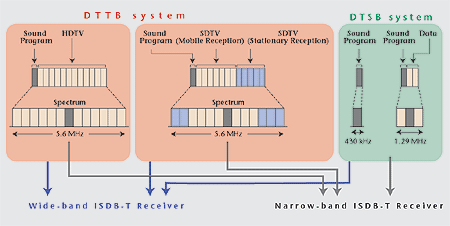 |
| Figure 1: Examples of ISDB-T transmission |
The OFDM segment bandwidth is equivalent to 1/14th of a television channel,
for example, about 430 kHz (6/14 MHz) in Japan. Three kinds of modes are
used, depending on the OFDM carrier spacing. These spacings are approximately
4 kHz (mode 1), 2 kHz (mode 2) and 1 kHz (mode 3). They translate into
effective symbol durations of 252 (mode 1), 504 (mode 2), and 1,008 s
(mode 3). Guard intervals can be selected from among four lengths; 1/4,
1/8, 1/16, and 1/32 of the effective symbol duration. Multipath interference
is suppressed by inserting a guard interval in the time domain, thus enabling
the system to operate in SFN [3]. Four modulation schemes are supported:
QPSK, 16QAM, 64QAM, and DQPSK. Error correction is handled by concatenated
codes using convolutional code for the inner code and Reed-Solomon code
for outer one. Any time interleaving length ranging between 0 sec and
about 1 sec can be specified. s
(mode 3). Guard intervals can be selected from among four lengths; 1/4,
1/8, 1/16, and 1/32 of the effective symbol duration. Multipath interference
is suppressed by inserting a guard interval in the time domain, thus enabling
the system to operate in SFN [3]. Four modulation schemes are supported:
QPSK, 16QAM, 64QAM, and DQPSK. Error correction is handled by concatenated
codes using convolutional code for the inner code and Reed-Solomon code
for outer one. Any time interleaving length ranging between 0 sec and
about 1 sec can be specified.
| Table 1: Tokyo Tower
transmission conditions |
Transmitter
Frequency |
485.15 MHz
(center frequency) |
| Transmitter |
100 W |
| Power Polarization |
Linear-vertical |
| Antenna Height |
261 m |
| E.R.P. |
395 W |
During the Tokyo DTTB field trials, the ISDB-T signal was transmitted
in the UHF band [4]. The transmission conditions are listed in Table 1.
The transmission parameters used in the stationary reception experiments
are listed in Table 2. The number of measured points is 127. These points
are shown in Figure 2. The location rates of correct reception are plotted
in Figure 3. The required minimum field strength for 99%-correct reception
(S1 and S3) was about 57 dB V/m. V/m.
The transmission parameters used for the mobile reception experiments
are listed in Table 3. The bit error rates and field strengths over the
measured routes are shown in Figure 4. Figure 5 shows the time rates of
correct reception. The required minimum field strength for 99%-correct
reception (M1) was about 51 dB V/m.
The figure compares the correct reception rates for transmission with
(M1) and without (M2) time interleaving. The required minimum field strength
for 99%-correct reception with time interleaving was about 10 dB lower.
We conclude that time interleaving is very effective in mobile reception. V/m.
The figure compares the correct reception rates for transmission with
(M1) and without (M2) time interleaving. The required minimum field strength
for 99%-correct reception with time interleaving was about 10 dB lower.
We conclude that time interleaving is very effective in mobile reception.
| Table 2: Stationary reception parameters |
|
|
| No. |
S1 |
S2 |
S3 |
| Mode |
3 |
2 |
| Guard Interval
Ratios |
1/16 (63 s) s) |
1/8 (63 s) s) |
| Number of
Segments |
13 |
1 |
12 |
| Carrier Modulations |
64QAM |
DQPSK |
64QAM |
| Inner Code
Rates |
5/6 |
1/2 |
7/8 |
| Time Interleaving |
0 ms |
0 ms |
0 ms |
| Information
Rates |
21.47Mbps |
312kbps |
19.66Mbps |
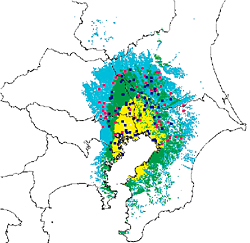
|
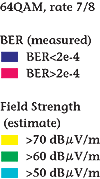
|
| Figure 2: Measured
BER for S3 condition |
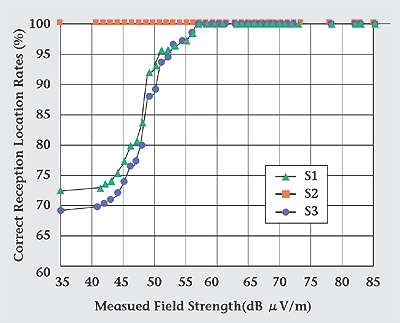 |
| Figure 3: Correct reception location rates
|
| Table 3: Mobile reception parameters |
 |
Mobile Reception |
| No. |
M1 |
M2 |
| Mode |
2 |
| Guard Interval
Ratios |
1/8 (63 s) s) |
| Number of
Segments |
13 |
| Carrier
Modulations |
DQPSK |
DQPSK |
| Inner Code
Rates |
1/2 |
1/2 |
| Time Interleaving |
427.5 ms |
0 ms |
| Information
Rates |
4.06 Mbps |
4.06 Mbps |
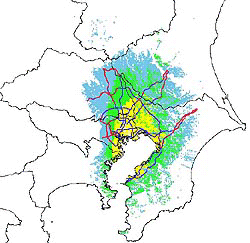
|
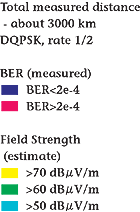 |
| Figure 4: Measured BER in M1 condition |
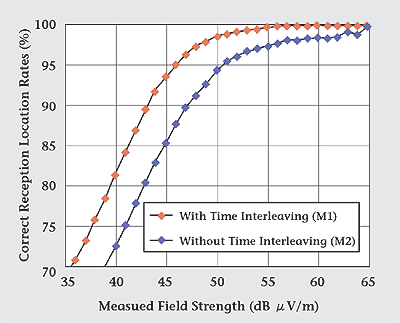 |
| Figure 5: Time rates of correct reception |
ISDB-TSB (ISDB-T for Sound Broadcasting system
has two kinds of bandwidths: a single segment, and an extended version
using triple segments. The information bit rate of the system ranges from
280 kbps to 5.3 Mbps depending on the combination of transmission parameters.
Table 4 shows two service examples using coding rate of covolutional code
1/2, which is the robustest coding rate of this system. In the case of
carrier modulation scheme DQPSK, one stereo audio program, Electric Programming
Guide (EPG), still pictures and files can be broadcasted within the bit
rate of about 330 kbps. In the case of 16QAM, two stereo audio programs,
EPG, motion picture and files can be broadcasted within the bit rate of
about 660 kbps.
| Table 4: Service examples of narrow-band
ISDB-TSB |
| Number
of Segments |
1-segment |
| Guard
interval ratio |
1/16
|
| Inner
code rate |
1/2 |
| Carrier
modulation |
DQPSK
|
16QAM |
| Information
bit rate |
330.42
kbps |
660.84
kbps |
| Stereo
audio |
144
kbps (1 program) |
288
kbps (2 programs) |
| Character
(include EPG) |
16 kbps |
16 kbps |
| Picture |
64 kbps
(still) |
256
kbps (motion) |
| File
(ex. newspaper) |
32 kbps
|
32 kbps
|
| Control |
64 kbps |
64 kbps |
| Total
bit rate |
320
kbps |
656
kbps |
| Table 5:
Outline of experimental transmitter |
| Transmitter Frequency |
190 MHz |
| Transmitter Power |
100 W |
| Polarization |
Linear-vertical |
| Antenna Height |
247.5 m |
| Max. ERP |
800 W |
In Tokyo area, the trials of mobile reception were carried out using the
single-segment system. The transmission condition and parameters used
in the trials are listed in Table 5 and Table 6 respectively. For the
receiver antenna, a dipole antenna was installed on the roof of a vehicle.
The height of the receiver antenna is 1.8 m. The receiving vehicle ran
approximately 700km on main roads including expressway and main arterial
road.
Figure 6 shows the correct reception time rates on the measurement course.
For example, to obtain a correct reception time rate of 99%, it was found
that the DQPSK modulation requires a field strength of 38 dB V/m
and the 16QAM requires a field strength of 44 dB V/m
and the 16QAM requires a field strength of 44 dB V/m.
From the results, it was found that DQPSK was approximately 6dB more robust
than 16QAM in mobile reception environment. V/m.
From the results, it was found that DQPSK was approximately 6dB more robust
than 16QAM in mobile reception environment.
| Table 6: Transmission
parameters of mobile reception trial for ISDB-TSB |
| Mode |
Guard ratio |
Time interleaving |
Carrier modulation |
Error correction |
| 3 |
1/16 |
407ms |
DQPSK |
1/2+RS |
| 3 |
1/16 |
407ms |
16QAM |
1/2+RS |
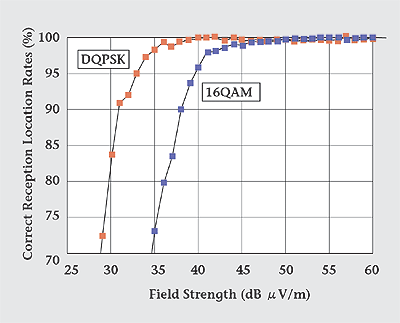 |
| Figure 6: Correct reception time rates for
each field strength of wide-area mobile reception trial |
In the Tokyo pilot project, application tests that involved the transmission
of video, sound, and data, using signals that were close to those of actual
services, were conducted. In these test, function verifications for the
reception of data transmitted in conjunction with TV programs were carried
out. These verifications focused on the transmission and reception of
independent data services (i.e., news and weather forecasts) and program-linked
data services.
| 6. ISDB-T Facilities in Japan |
|
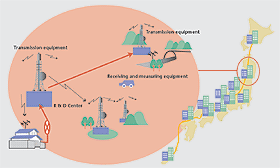 |
| Figure 7: ISDB-T facilities in Japan |
The Ministry of Posts and Telecommunications (MPT) launched
several facilities to accelerate DTTB and DTSB services throughout Japan.
The pilot broadcast stations were set up in 11 major areas in 1998 (Figure
7). The output powers of the main stations are over the kW range. Some
stations have a number of relay stations used to verify SFN. All the facilities
are capable of providing HDTV, SDTV and data services with multimedia
applications and interactive functions.
Digital satellite broadcasting began service using ISDB-S in December
of last year in Japan. ISDB-T is designed to be compatible with ISDB-S.
ISDB-T receivers can use the same devices as ISDB-S receivers, except
for the ISDB-T-oriented OFDM chip. The common receiver will be also available.
Regarding multimedia facilities, Digital Satellite Broadcasting using
ISDB-S provides datacasting services and interactive services. It is obvious
that the same technologies and facilities will be easily implemented for
ISDB-T.
References
| [1] |
T. Kuroda and M. Sasaki : "Terrestrial ISDB System using Band
Segmented Transmission Scheme", International Television Symposium,
ITVS 20, pp. 641-654 (1997) |
| [2] |
M. Takada, M. Sasaki, T. Ikeda: "Draft Standard for Digital Terrestrial
Sound Broadcasting in Japan", NAB 53rd Annual Broadcasting Engineering
Conference (1999) |
| [3] |
S. Nakahara, S. Moriyama, T. Kuroda, M. Sasaki, S. Yamazaki, and
O. Yamada : "Efficient Use of Frequencies In Terrestrial ISDB System",
IEEE Trans. On Broadcasting, Vol. 42, No. 3, pp. 173-178 (1996) |
| [4] |
S. Moriyama, M. Takada, S. Nakahara, H. Miyazawa : "Progress Report
of ISDB-T System", Broadcast Asia 2000 |
|





